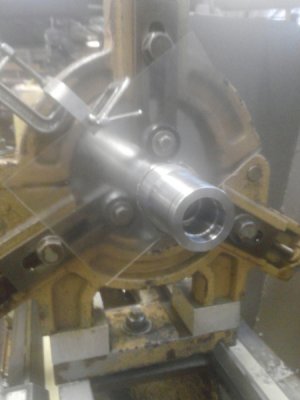- Joined
- Jan 20, 2016
- Messages
- 602
I need to thread a 1.5" 316 seamless tube on my PM 1030v lathe. I have done this kind of thing in the past with a HF 7x12 lathe but it was kind of a hack job and I wan't more precision now.
I turned down a plug to put in the tube until it was a very tight fit. Then I stuck it in the 4 jaw and tried to indicate it as true as I could at the spindle. I was able to get it to about .004" and then I was getting two peaks and two lows. As in jaw 1 was 0.00", jaw 2 was .004", jaw 3 was .000" and jaw 4 was .004 again. That made me think it was ovalled out. Am I expecting too much from the tube? Should I turn down a slightly larger plug and use a mallet to force it in? Is there a way to tell if the tube is no good? The first tube was no good, I think from my cut off saw. It was bent all over the place.
Once I get it dialed in at the spindle, whats the best way to get it dialed in straight? When I got it dialed to .004" it was off by about .030" at 12" out. Is there a way to dial it in at the steady while keeping it straight?
I turned down a plug to put in the tube until it was a very tight fit. Then I stuck it in the 4 jaw and tried to indicate it as true as I could at the spindle. I was able to get it to about .004" and then I was getting two peaks and two lows. As in jaw 1 was 0.00", jaw 2 was .004", jaw 3 was .000" and jaw 4 was .004 again. That made me think it was ovalled out. Am I expecting too much from the tube? Should I turn down a slightly larger plug and use a mallet to force it in? Is there a way to tell if the tube is no good? The first tube was no good, I think from my cut off saw. It was bent all over the place.
Once I get it dialed in at the spindle, whats the best way to get it dialed in straight? When I got it dialed to .004" it was off by about .030" at 12" out. Is there a way to dial it in at the steady while keeping it straight?


